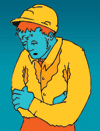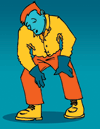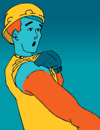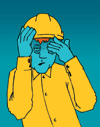The long, hot summer days are upon us in most regions of the U.S., and with them come additional challenges for keeping roofing workers safe from some obvious and not-so-obvious sources of injury. The training aids in this pullout are designed to provide you with a quick reference for some of the hazards workers may face during the summer and ways to help minimize their effects.
 |
Heat cramps
Symptoms
- Painful muscle cramps or spasms, usually in the back, abdomen or legs
Causes
- Inadequate fluid intake during exercise or physical activity in hot weather
Treatment
- Rest and cool off.
- Drink water or sports drinks containing electrolytes.
- Avoid alcoholic beverages.
- Gently stretch or massage the affected areas.
- If cramping does not subside within an hour, visit a licensed health care professional for further treatment.
 |
Heat exhaustion
Symptoms
- Profuse sweating
- Nausea
- Dizziness
- Weakness or fatigue
- Pale, cool and moist skin
- Rapid, weak heartbeat
- Fast, shallow breathing
- Feeling faint
Causes
- Usually the result of heavy physical activity or exercise in hot weather
- Insufficient intake of fluids
Treatment
- Move out of the sun and into a shady or air-conditioned area.
- Drink water or sports drinks containing electrolytes.
- Avoid alcoholic beverages.
- Lie down and elevate feet above head level.
- Loosen clothing or remove it if possible.
- Take a cool shower or bath or mist or sponge with water to help lower temperature.
- If symptoms worsen or do not improve, call 911. Heat exhaustion can quickly become heat stroke—a life-threatening condition.
 |
Sunburn
Symptoms
- Red, warm skin
- Burn may be painful or tender to touch
- Swelling and blisters in severe cases
- Headache, fever, nausea or fatigue can be present in severe exposures.
- Sunburned eyes may be red, dry and painful and feel gritty—chronic exposure can lead to cataracts and macular degeneration.
- Symptoms may not appear for hours after exposure.
Causes
- Ultraviolet light from the sun, even on cloudy days
- Lighter-skinned people are most susceptible.
- Duration of exposure, time of day and year, geographical elevation and surrounding environment (water, sand or light-colored surfaces) can affect the severity of the sun's rays.
- Some medications, such as diuretics, certain antibiotics and anti-inflammatory drugs, can increase a person's sensitivity to the sun.
Treatment
- Aspirin,® acetaminophen or ibuprofen may help.
- Cool compresses or baths can help reduce pain.
- Keep hydrated with water or electrolyte-containing sports drinks.
- Moisturizing creams containing aloe or 1 percent hydrocortisone can speed healing.
- Blisters should not be broken, but antiseptic ointment or 1 percent hydrocortisone cream should be applied if they break to prevent infection and assist healing.
- Severe blistering or extreme pain requires the attention of a licensed health care professional.
Prevention
- A full-spectrum sunscreen with an SPF of at least 15 should be applied a minimum of 20 minutes before exposure, even on cloudy days.
- Wear clothing with SPF ratings.
- Sunglasses are a must for minimizing sun exposure to the eyes; tinted safety glasses accomplish the dual goals of sun protection and protecting the eyes from flying objects.
- Wear a hat to reduce the risk of sun exposure to the head and help shield the eyes.
- Sun protection is a must even for those with darker skin. The National Safety Council reports repeated overexposure to the sun can damage a person's immune system. Even mild sunburn can limit the body's disease-fighting ability for up to 24 hours, and the effect is not limited to only those with light skin.
 |
Heat stroke
Symptoms
- Extremely high body temperature (higher than 103 F)
- Red, hot and dry skin
- Unconsciousness
- Confusion
- Rapid heartbeat and breathing
- Headache
- Dizziness
- Fainting
Causes
- Heavy physical activity or exercise in hot weather
- Insufficient intake of fluids
- Being older or obese
- Alcohol use, cardiovascular disease, high blood pressure and some medications
Treatment
- Call 911.
- Move to the shade or into an air-conditioned area.
- Remove clothing, mist with water, or immerse in a cool bath or shower.
- Failure to get treatment can cause death or permanent disability.
 |
Insect bites and stings
Symptoms
- Swelling and pain at the site of the bite or sting
- Itching near the area of the bite or sting
- Allergic reactions may result because of oversensitivity to the venom or other substance introduced by the bite or sting—called anaphylaxis—including the following:
- Difficulty breathing
- Swelling of throat
- Cramps, nausea or vomiting
- Significant swelling at the bite or sting location
- Dizziness or fainting
- Hives or rash
- Rapid heartbeat
Treatment
- Severe allergic reactions to insect stings and bites can be life-threatening if you are oversensitive to the venom.
- Call 911 or seek immediate medical assistance in such situations.
- Wash the area thoroughly with antiseptic soap and water.
- Apply ice or a cold pack.
- An antihistamine such as Benadryl® can help open breathing passages.
- If you are sensitive to insect bites, consider carrying a pen-like device that can automatically inject a measured amount of drug, usually epinephrine, when pressed against the skin to counteract a sting or bite.
- Hydrocortisone cream or calamine lotion can provide relief to the immediate area of the bite or sting.
